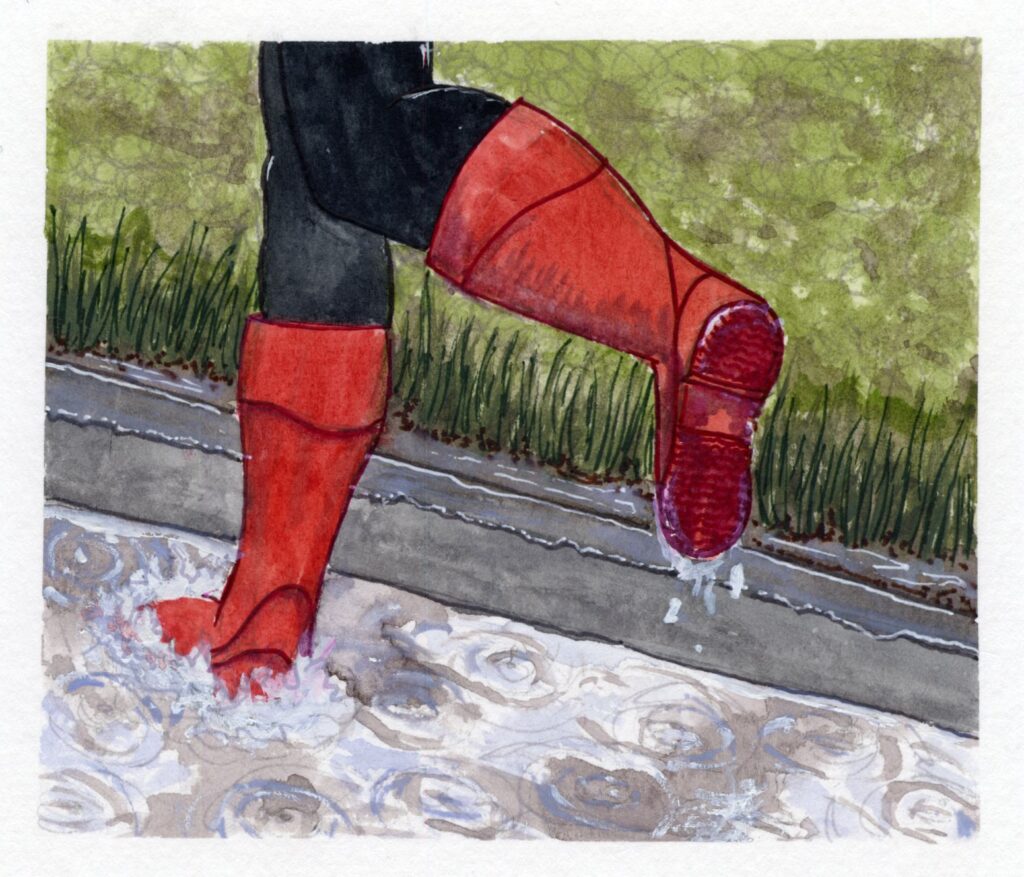By Anna Grez ’27
Staff Writer
When I read in the news that a massive rainstorm was coming to California in early February, dumping a predicted 10 inches of rain, the Pacific-Northwesterner in me scoffed. Coming from an extremely rainy part of Washington state — imagine Forks from Twilight — I’ve dealt with more than my fair share of rain and the flooding that comes with it.
The rain started to come, and with it came hopes of classes being canceled due to the “adverse conditions.” I laughed at the absurdity of rain canceling anything at all, much less school. And then the rain continued.
Streets flooded, classes were canceled, and my platform Doc Martens which got me through many wet Washington winters were suddenly not enough to elevate me above the flowing streams. I was confused — how could rain, so much like what I am accustomed to at home, be bringing with it seriously hazardous conditions?
The storm, the product of a particularly formidable atmospheric river strengthened by the warmer waters during this El Niño year, delivered a stream of intense rain to California over the first and second weeks of February. According to NASA’s Earth Observatory, the rainfall between the second and sixth exceeded 13 inches in parts of Los Angeles County.
With the rain came extreme flash flooding, mudslides, fallen trees, and power outages. The Los Angeles Times reported nine deaths: four by fallen trees, at least three by car wrecks, and one due to the storm’s resulting power outages. Half a million people were still out of power by Feb. 9.
California’s issue is not necessarily the rain itself — the precipitation replenishes aquifers and reduces fire hazards. The problem stems from the state’s lack of infrastructure and antiquated water conservation systems.
Flash flooding, the most immediate, and arguably most dangerous product of rain, strongly impacts densely populated areas and is a concern anywhere with lots of development. Buildings, highways, driveways, and parking lots increase runoff as the water cannot simply be absorbed by soil and vegetation. Accompanied by improper drainage, flash flooding is inevitable.
This is ever present in Southern California — in an attempt to control flooding in the 1930s, the Army Corps of Engineers chose to encase the entirety of the Los Angeles River in concrete. Due to the city’s status as a concrete jungle, hazardous and dirty runoff ends up in this anti-flooding-channel, contributing to dangerous water conditions.
The river’s ability to contain water and reduce flooding is not entirely sound, as areas along the southern part of the river still flood and impact over 1 million people. Further complicating the issue, the communities endangered by these conditions are disproportionately Black and Hispanic.
“Well, in general, California gets very little rain and so the change of having more rain — we’re not prepared for it, which kind of sucks considering the climate crisis,” Southern California native Anna Odell ’27 said. “It’s definitely going to be an issue that continues to happen in the future so I feel like we should start to address our drainage issues.”
Improper drainage can also destroy many of California’s plant ecosystems. More accustomed to drought, much of California’s landscaped areas are populated with drought-resistant plants that require little rainfall. When rain does fall, and falls hard, these plants are drowned rather than replenished.
Southern California’s vegetation and soils are also a factor in the lack of absorbency. Unlike the grasses and plants of Washington’s rainforests, which absorb up to 180 inches of rain each year, California’s native grasses and vegetation do not have the same capabilities. As a result of the soil’s low water capacity, standing water becomes an additional issue.
While El Niño certainly contributed to the elevated rainfall and higher levels of precipitation California has seen in 2024, it is not the sole cause. Increased global temperatures allow for air to hold more moisture, causing greater volumes of water vapor to be stored, and higher levels of precipitation. The EPA states that global average surface temperature has risen at an average rate of 0.17 degrees Fahrenheit each decade since 1901, increasing about 1 degree Fahrenheit in the last 100 years. Among the disastrous predictions of what climate change may bring is damage to the state’s water management and supply.
There is encouraging news about protecting California’s water systems, though. In December 2023, the Department of Water Resources approved the Delta Convergence Project, a network of waterways that will collect water in the Sacramento-San Joaquin Delta and distribute it throughout the state. This new infrastructure will better preserve the water supply, protecting it from predicted losses from sea level rise and earthquakes. Climate change is predicted to bring increased rain throughout California, and this new system will act as a safeguard against saltwater intrusion, while simultaneously taking advantage of increased rainfall.
After my first California rainstorm, I finally understand how different the same amount of rain can look in two places. While I feel lucky to have the knowledge of a Washington resident, California’s frightening lack of preparedness and infrastructure has prompted me to reassess my previous judgments. And after getting over my embarrassment, I am seriously considering investing in an umbrella for next year.
Image Source: Anna Grez ’27



